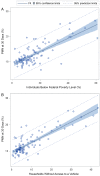Poverty, Transportation Access, and Medication Nonadherence
- PMID: 29610400
- PMCID: PMC5869333
- DOI: 10.1542/peds.2017-3402
Poverty, Transportation Access, and Medication Nonadherence
Abstract
Background and objectives: Variability in primary medication nonadherence (PMN), or failure to fill a new prescription, influences disparities and widens equity gaps. This study sought to evaluate PMN across 1 metropolitan area and assess relationships with underlying zip code-level measures.
Methods: This was a retrospective observational study using data extracted from 1 regional community pharmacy market-share leader (October 2016-April 2017). Data included patient age, sex, payer, medication type, and home zip code. This zip code was connected to US census measures enumerating poverty and vehicle access, which were treated as continuous variables and within quintiles. The prescription-level outcome was whether prescriptions were not filled within 30 days of reaching the pharmacy. The ecological-level outcome was PMN calculated for each zip code (numerator, unfilled prescriptions; denominator, received prescriptions).
Results: There were 213 719 prescriptions received by 54 included pharmacies; 12.2% were unfilled. Older children, boys, and those with public insurance were more likely to have prescriptions not filled. Prescriptions originating from the highest poverty quintile were significantly more likely to not be filled than those from the lowest poverty quintile (adjusted odds ratio 1.60; 95% confidence interval 1.52-1.69); a similar pattern was noted for vehicle access (adjusted odds ratio 1.77; 95% confidence interval 1.68-1.87). At the ecological level, there were significant, graded relationships between PMN rates and poverty and vehicle access (both P < .0001); these gradients extended across all medication classes.
Conclusions: Poverty and vehicle access are related to significant differences in prescription- and ecological-level PMN across 1 metropolitan area. Pharmacists and pharmacies can be key partners in population health efforts.
Copyright © 2018 by the American Academy of Pediatrics.
Conflict of interest statement
POTENTIAL CONFLICT OF INTEREST: Dr Heaton owns stock in The Kroger Company; The Kroger Company also provides funding to the University of Cincinnati James L. Winkle College of Pharmacy, but Dr Heaton received no funding from Kroger for her work on this project. Dr Frede works for Kroger Pharmacy. Dr Luder now works for Pfizer Inc. None of those listed received any support from these entities for this work; the other authors have indicated they have no potential conflicts of interest to disclose.
Figures



Similar articles
-
Store and prescription characteristics associated with primary medication nonadherence.J Manag Care Spec Pharm. 2014 Aug;20(8):824-32. doi: 10.18553/jmcp.2014.20.8.824. J Manag Care Spec Pharm. 2014. PMID: 25062076 Free PMC article.
-
Pharmacy-based interventions to reduce primary medication nonadherence to cardiovascular medications.Med Care. 2014 Dec;52(12):1050-4. doi: 10.1097/MLR.0000000000000247. Med Care. 2014. PMID: 25322157
-
Financial impact of patients enrolled in a medication adherence program at an independent community pharmacy.J Am Pharm Assoc (2003). 2018 Jul-Aug;58(4S):S109-S113. doi: 10.1016/j.japh.2018.04.022. J Am Pharm Assoc (2003). 2018. PMID: 30006182
-
Low rates of primary medication nonadherence in patients prescribed oral oncology agents across health system specialty pharmacies.J Manag Care Spec Pharm. 2023 Jul;29(7):740-748. doi: 10.18553/jmcp.2023.29.7.740. J Manag Care Spec Pharm. 2023. PMID: 37404071 Free PMC article.
-
The epidemiology of prescriptions abandoned at the pharmacy.Ann Intern Med. 2010 Nov 16;153(10):633-40. doi: 10.7326/0003-4819-153-10-201011160-00005. Ann Intern Med. 2010. PMID: 21079218
Cited by
-
A pilot mixed-methods randomized controlled trial of verbal versus electronic screening for adverse social determinants of health.J Am Coll Emerg Physicians Open. 2022 Feb 15;3(1):e12678. doi: 10.1002/emp2.12678. eCollection 2022 Feb. J Am Coll Emerg Physicians Open. 2022. PMID: 35224551 Free PMC article.
-
Paid Family Leave to Enhance the Health Outcomes of Preterm Infants.Policy Polit Nurs Pract. 2018 Feb-May;19(1-2):11-28. doi: 10.1177/1527154418791821. Epub 2018 Aug 22. Policy Polit Nurs Pract. 2018. PMID: 30134774 Free PMC article.
-
Pediatric Medication Noninitiation in Spain.Pediatrics. 2022 Jan 1;149(1):e2020034371. doi: 10.1542/peds.2020-034371. Pediatrics. 2022. PMID: 34957504 Free PMC article.
-
The association of neighborhood-level deprivation with glioblastoma outcomes: a single center cohort study.J Neurooncol. 2025 Jun;173(2):457-467. doi: 10.1007/s11060-025-05002-3. Epub 2025 Apr 7. J Neurooncol. 2025. PMID: 40193021 Free PMC article.
-
Material economic hardships are associated with adverse 1-year outcomes after pediatric liver transplantation: Prospective cohort results from the multicenter SOCIAL-Tx Study.Liver Transpl. 2025 Aug 1;31(8):1042-1052. doi: 10.1097/LVT.0000000000000554. Epub 2024 Dec 16. Liver Transpl. 2025. PMID: 39692470
References
-
- Haynes RB, Ackloo E, Sahota N, McDonald HP, Yao X. Interventions for enhancing medication adherence. Cochrane Database Syst Rev. 2008;(2):CD000011. - PubMed
-
- Haynes RB, McKibbon KA, Kanani R. Systematic review of randomised trials of interventions to assist patients to follow prescriptions for medications. Lancet. 1996;348(9024):383–386 - PubMed
-
- McDermott MM, Schmitt B, Wallner E. Impact of medication nonadherence on coronary heart disease outcomes. A critical review. Arch Intern Med. 1997;157(17):1921–1929 - PubMed
-
- Andrade SE, Kahler KH, Frech F, Chan KA. Methods for evaluation of medication adherence and persistence using automated databases. Pharmacoepidemiol Drug Saf. 2006;15(8):565–574; discussion 575–577 - PubMed
Publication types
MeSH terms
Substances
Grants and funding
LinkOut - more resources
Full Text Sources
Other Literature Sources
Miscellaneous

